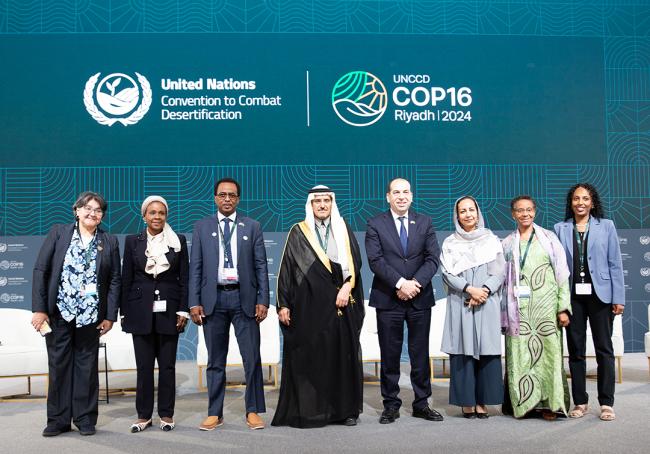About
Resilience against drought means many things, rainwater harvesting, tree planting, the chance of owning one’s land—and restoring hope to people displaced by climate impacts. Thematic sessions today showed how these are connected.
Resilience was the theme of the day’s side events, which united diverse topics, ranging from managing forest fires in arid areas, to drought monitoring technology, early warning systems (EWS), partnerships for freshwater conservation, and tackling sand and dust storms.
In the Green Zone—the section of the conference venue dedicated to exhibits and lightning talks—organizations showcased their land restoration and resilience actions. In the Blue Zone, where the negotiations and side events are taking place, the Delegates Pavilion showcased aspects of national and cultural heritage. A life-size camel model from Saudi Arabia gazed serenely at visitors, while the Mongolian pavilion sported a brown bear plushie, representing the Gobi Bear, perched behind some miniature yurts.
During a high-level session at the close of Resilience Day, Fatimata Cheiffou, Ambassador of Niger to Italy, highlighted the personal and public dimensions of resilience. Introducing herself as a member of a nomadic community, she stated that this heritage has provided her people with a deep understanding of the importance of resilience, including the appreciation of “Nature as our marketplace, our pharmacy, and our sanctuary.” She emphasized that the health of land is inseparable from the health of its people, and called for collective action for land restoration.
Abdulaziz Al Shaibani, Deputy Minister for Water, Ministry of Environment, Water and Agriculture, Saudi Arabia, described progress on action for resilience in the water sector, including the construction of terraces for rain harvesting, building reservoirs for storing the scarce rainfall when it comes, and land restoration projects undertaken by the National Center for Vegetation Cover Development and Combating Desertification. He expressed a need for an intergovernmental body or international organization to develop strategies for resilience, especially with regard to drought mitigation, which, he suggested, could connect the work being done in the water, food, agriculture, and environment sectors.
Kodou Choukou Tidjani, Director, National Agency of the Great Green Wall, and Ministry of Environment, Chad, drew attention to Chad’s desertification crisis and population displacement, including the influx of refugees from Sudan and the Central African Republic. He called on the global community to give attention to the people of the Sahel, who have no means of subsistence and, therefore, are joining armed rebel groups such as Boko Haram. He highlighted national initiatives to counter the advance of the desert by 2.5 km every five years, such as land allocation for farming and National Tree Week, when every citizen plants at least one tree.
Abdallah Alwardat, Director, Global Partner Countries, World Food Programme (WFP), stated that Resilience Day is a reminder that drought and desertification are not only environmental crises but also contribute to hunger, poverty, and displacement. He urged all world leaders and citizens to unite to accelerate the restoration of degraded lands through approaches such as regenerative agriculture and water harvesting, which, he said will create jobs and promote more resilient food value chains. He added that enhancing EWS will complement land restoration efforts. Finally, he noted that land restoration efforts will be limited if resourcing is inadequate and called for large-scale, converging programmes that place communities and host governments at the center, and are supported by blended financing from multiple sources.
Safaa El Tayeb El-Kogali, Country Director, Gulf Cooperation Countries, World Bank, recalled that the day’s discussions had focused on the interconnectedness of the challenges and solutions related to land degradation, water scarcity, drought, and desertification. On the question of water scarcity, she identified several priorities. First, she underlined the importance of strong institutions and governance around water management, recalling that low water service fees for irrigation gives a perverse incentive to farmers to grow water-intensive crops in arid areas. Second, she invoked significant investment needs, particularly given the impacts of climate change and growing populations. Accurate climate change and hydrological data are also needed to inform decision making, she added. For the Middle East and North Africa (MENA) region, she emphasized the need for stronger frameworks to manage shared water resources.
Birguy Lamizana Diallo, Chief of Global Policy, Advocacy and Regional Cooperation, UNCCD, gave a heartfelt thanks, on behalf of UNCCD Deputy Secretary Andrea Meza, to Saudi Arabia, the World Bank, the WFP, and the World Meteorological Organization (WMO) for their collaboration and hard work on Resilience Day. She reiterated that the Day was designed to highlight the interconnections across issues such as drought resilience, water scarcity, and sand and dust storms, and to bring together countries at COP 16 to share their experiences.
Organizers: UNCCD, World Bank Group, WMO, WFP
Contact: yumlauf@unccd.int
Website: Resilience Day



















